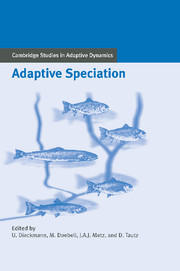Book contents
- Frontmatter
- Contents
- Contributing Authors
- Acknowledgments
- Notational Standards
- 1 Introduction
- 2 Speciation in Historical Perspective
- A Theories of Speciation
- B Ecological Mechanisms of Speciation
- C Patterns of Speciation
- 15 Phylogeography and Patterns of Incipient Speciation
- 16 Evolutionary Diversification of Caribbean Anolis Lizards
- 17 Adaptive Radiation of African Montane Plants
- 18 Diversity and Speciation of Semionotid Fishes in Mesozoic Rift Lakes
- 19 Epilogue
- References
- Index
15 - Phylogeography and Patterns of Incipient Speciation
Published online by Cambridge University Press: 05 July 2014
- Frontmatter
- Contents
- Contributing Authors
- Acknowledgments
- Notational Standards
- 1 Introduction
- 2 Speciation in Historical Perspective
- A Theories of Speciation
- B Ecological Mechanisms of Speciation
- C Patterns of Speciation
- 15 Phylogeography and Patterns of Incipient Speciation
- 16 Evolutionary Diversification of Caribbean Anolis Lizards
- 17 Adaptive Radiation of African Montane Plants
- 18 Diversity and Speciation of Semionotid Fishes in Mesozoic Rift Lakes
- 19 Epilogue
- References
- Index
Summary
Introduction
The term “phylogeography” was introduced by Avise (Avise et al. 1987) to refer to the principles and processes that govern the geographic distributions of genealogical lineages, including those at the intra-specific level (Avise 1994). Since then, the use of DNA markers to study phylogeography has become very popular, with an increasing flood of studies on a diverse range of taxa. The data from these studies are interpreted traditionally within the framework of limited dispersal (isolation by distance) or past vicariance events (isolation by geographic barriers), considered against the geographic and geologic history of the area under study. The resultant patterns are then discussed in the context of passive divergence and are taken as evidence for allopatric speciation scenarios. However, the argument presented here is that at least some of these patterns could also be seen in a different light and might provide evidence for sympatric modes of speciation.
The crucial point in this context is that the consequences of assortative mating should be considered for the generation of patchy distribution patterns, as well as for the maintenance of borders between the patches. The evolution of assortative mating is generally an integral part of sympatric speciation models, both for the ecologically driven ones (Rice 1987; Doebeli 1996a; Johnson et al. 1996b; Dieckmann and Doebeli 1999; Kondrashov and Kondrashov 1999) and for those based on sexual selection (Turner and Burrows 1995; Higashi et al. 1999). In general, assortative mating amounts to an avoidance of hybridization under contact conditions.
- Type
- Chapter
- Information
- Adaptive Speciation , pp. 305 - 321Publisher: Cambridge University PressPrint publication year: 2004
- 4
- Cited by



